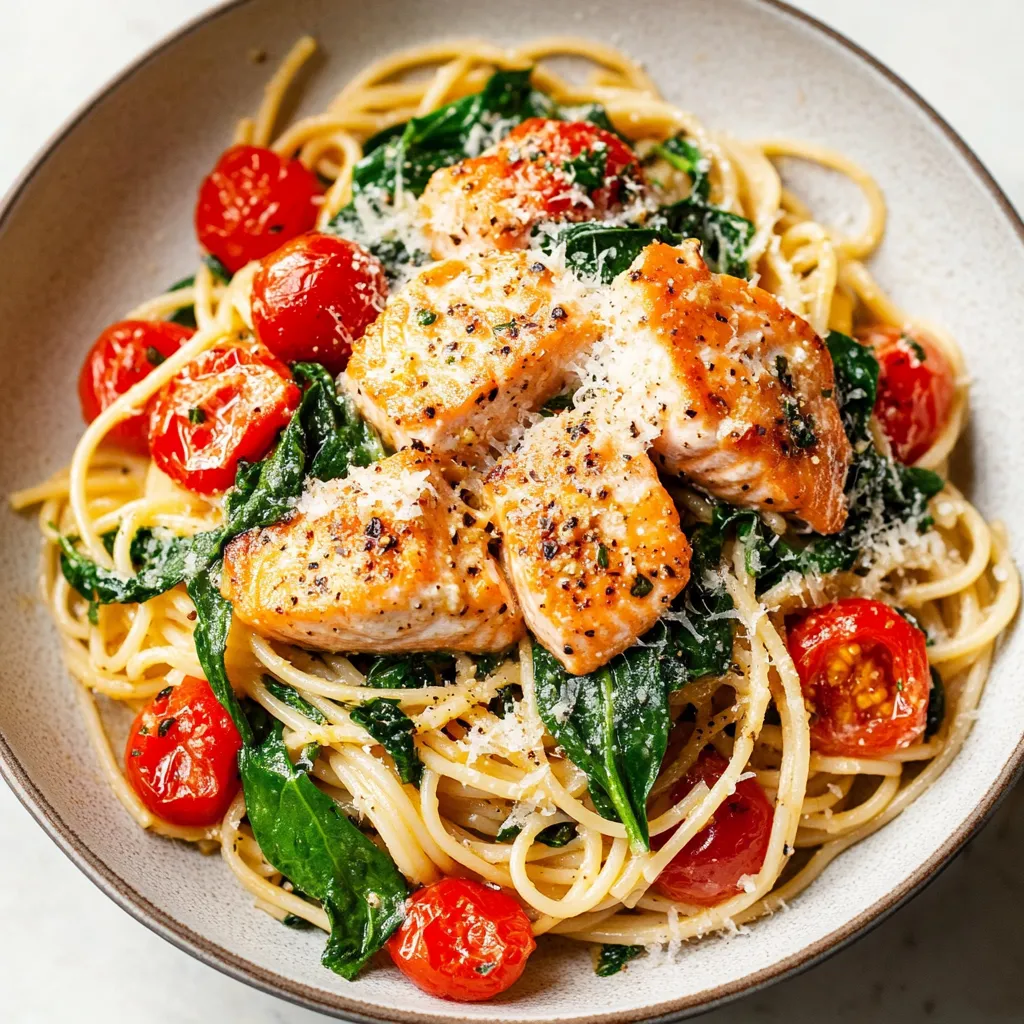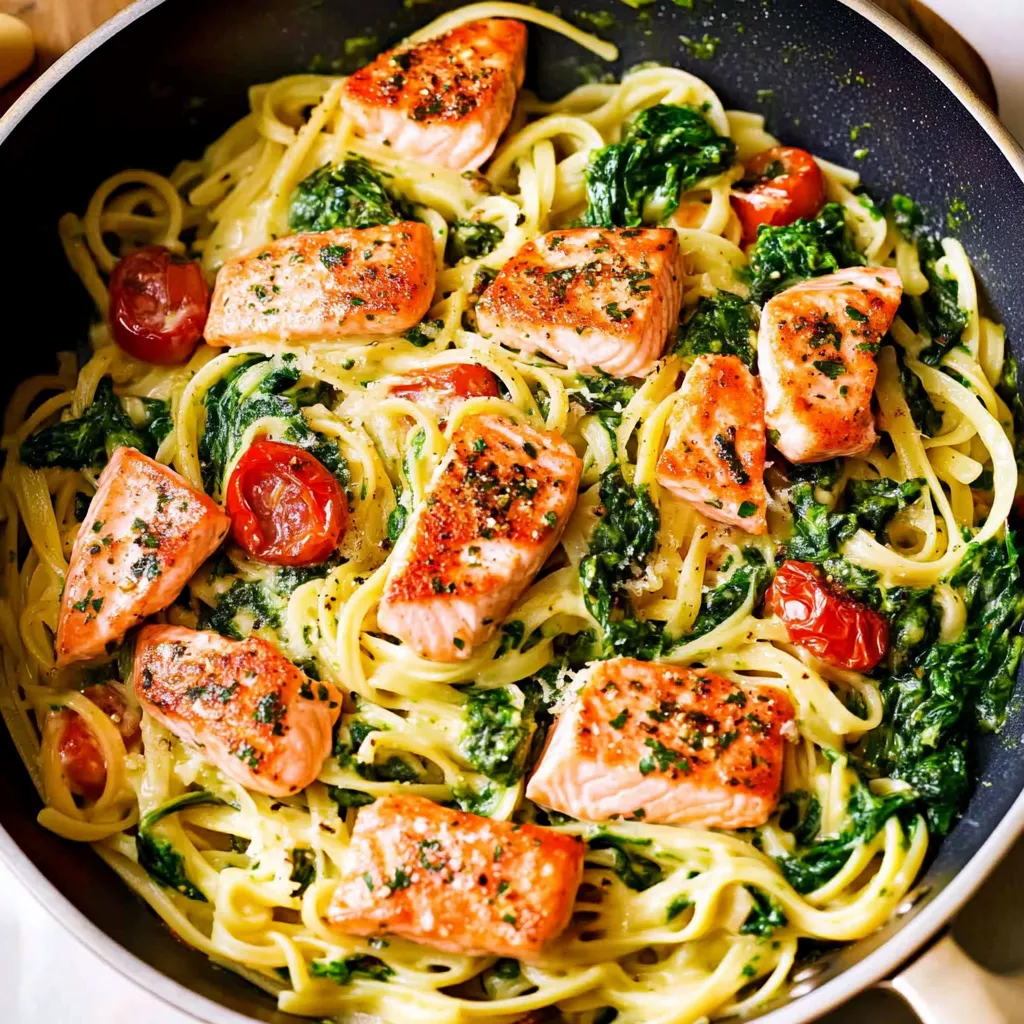 Pin it
Pin it
This elegantly simple tomato spinach salmon pasta transforms everyday ingredients into restaurant-quality comfort food that celebrates the natural sweetness of summer tomatoes while showcasing perfectly flaky salmon in a luxurious garlic butter sauce that feels both light and indulgent. The genius of this recipe lies in its timing and technique - the salmon is seared to golden perfection before being gently finished in the sauce, ensuring it remains tender and flaky while absorbing the bright flavors of burst cherry tomatoes, fresh spinach, and aromatic garlic. Unlike heavy, cream-laden pasta dishes that can feel overwhelming, this version achieves richness through quality ingredients and proper technique, creating a dish that feels sophisticated enough for entertaining yet simple enough for weeknight dinners when you want something special without spending hours in the kitchen.
I created this recipe during peak tomato season when I wanted to showcase the incredible sweetness of fresh cherry tomatoes alongside salmon in a way that felt both comforting and elegant. The breakthrough came when I realized that letting the tomatoes burst naturally in the pan creates their own sauce base, eliminating the need for heavy cream while maintaining the luxurious mouthfeel that makes pasta so satisfying.
Essential Ingredients and Selection Tips
- Fresh salmon fillet: Choose center-cut fillets about 1 inch thick with bright color and firm texture; avoid previously frozen if possible for best flavor and texture
- Ripe cherry tomatoes: Select tomatoes that yield slightly to pressure and have deep color; peak-season tomatoes will burst more easily and provide better sweetness
- Fresh baby spinach: Use tender young spinach leaves that will wilt quickly; avoid mature spinach with thick stems that can be tough
- Quality pasta: Choose long pasta shapes like spaghetti or linguine that hold sauce well; cook just to al dente since it finishes cooking in the sauce
- Dry white wine: Use crisp varieties like Sauvignon Blanc or Pinot Grigio for acidity that brightens the dish; avoid sweet wines that can throw off the balance
- Fresh garlic: Use plump, firm cloves without green sprouting; fresh garlic provides much better flavor than pre-minced versions
- Good olive oil and butter: Use extra virgin olive oil for flavor and high-quality butter for richness in the sauce base
The secret to perfect results is proper timing - the salmon should be just cooked through when the pasta finishes, allowing everything to come together at the optimal temperature.
Detailed Step-by-Step Instructions
- Step 1: Start the pasta water:
- Bring a large pot of well-salted water to a rolling boil. The water should taste like seawater for properly seasoned pasta.
- Step 2: Prepare the salmon:
- Pat salmon fillet dry and season all sides with garlic powder, salt, and pepper. Let it come to room temperature while preparing other ingredients.
- Step 3: Cook pasta to al dente:
- Add spaghetti to boiling water and cook according to package directions until just al dente. Reserve 1 cup pasta water before draining.
- Step 4: Heat the pan properly:
- Heat olive oil and butter in a large skillet over medium-high heat until the butter is melted and starting to foam slightly.
- Step 5: Sear the salmon perfectly:
- Add seasoned salmon to the hot pan and cook for 3-4 minutes per side until golden brown and crispy. Don't move it too soon - let it develop proper caramelization.
- Step 6: Rest the salmon:
- Transfer seared salmon to a plate and tent with foil. It will finish cooking in the sauce, so slight undercooking at this stage is ideal.
- Step 7: Build the aromatic base:
- In the same pan, add minced garlic and cook for 30 seconds until fragrant but not browned. The residual salmon fat adds incredible flavor.
- Step 8: Add tomatoes and seasonings:
- Add cherry tomatoes, white wine (or chicken broth), and Italian seasoning to the pan. Cook for 3-4 minutes, stirring occasionally.
- Step 9: Burst the tomatoes:
- Continue cooking until tomatoes begin to burst and release their juices, creating a natural sauce base. Some tomatoes should remain whole for texture contrast.
- Step 10: Finish the dish:
- Return salmon to the pan and gently break it into bite-sized pieces. Add fresh spinach and cook until just wilted. Toss with drained pasta and pasta water as needed for proper consistency.
 Pin it
Pin it
The most important technique is not overcooking the salmon - it should be just opaque in the center when finished since it continues cooking in the residual heat.
This tomato spinach salmon pasta has become my go-to example of how simple, quality ingredients can create restaurant-worthy results when prepared with proper technique and understanding of how flavors work together.
Understanding Salmon Cooking Science
Salmon contains delicate proteins that coagulate quickly under high heat, making proper temperature control crucial for maintaining moisture and flaky texture. The initial searing creates a flavorful crust through caramelization while the lower-temperature finishing in the sauce allows gentle cooking that preserves tenderness. Understanding this two-stage cooking process prevents the common mistake of overcooking that results in dry, tough fish.
Tomato Chemistry and Natural Sauce Development
Cherry tomatoes contain natural sugars, acids, and pectins that create sauce-like consistency when cooked properly. The heat breaks down cell walls, releasing juices that concentrate and thicken naturally while the sugars caramelize slightly for enhanced sweetness. The natural acidity balances the richness of salmon and butter while helping preserve the bright, fresh flavor that defines this dish.
Pasta Integration and Sauce Adhesion
The starchy pasta water acts as an emulsifier that helps bind the olive oil, butter, and tomato juices into a cohesive sauce that coats the pasta evenly. Adding pasta water gradually allows precise consistency control while the residual heat helps integrate all components. Understanding this technique prevents the common problem of sauce that separates or fails to coat properly.
Wine Selection and Acid Balance
Dry white wine provides acidity that brightens the overall dish while adding complexity to the sauce base. The alcohol cooks off during the process, leaving behind concentrated flavor compounds that enhance the natural sweetness of tomatoes and richness of salmon. The acidity also helps balance the butter and olive oil, preventing the dish from feeling too heavy.
Spinach Timing and Texture Preservation
Fresh spinach contains high water content and tender cell walls that break down quickly under heat. Adding it at the end preserves vibrant green color and prevents the bitter, metallic flavors that develop when spinach is overcooked. The residual heat from the pasta and sauce provides sufficient cooking while maintaining optimal texture and nutritional value.
This tomato spinach salmon pasta has taught me that the most satisfying meals often come from understanding how to let quality ingredients shine rather than masking them with heavy sauces or complicated techniques, proving that elegant cooking is often about restraint and proper timing rather than complexity. Every time I make it, I'm reminded that some of the best dinners are those that feel both comforting and sophisticated, creating meals that nourish both body and spirit while bringing the simple pleasure of perfectly prepared food to everyday life.
Frequently Asked Questions
- → Can I use frozen salmon for this recipe?
- Yes, just thaw it completely first and pat dry before seasoning. Fresh salmon works best but frozen is fine too.
- → What pasta shape works best besides spaghetti?
- Linguine, fettuccine, or penne all work great. Choose whatever you have on hand or prefer.
- → Can I skip the white wine?
- Absolutely! Use chicken broth instead or even just a splash of pasta water for moisture.
- → How do I know when the salmon is cooked through?
- The salmon should flake easily with a fork and reach 145°F internal temperature. It takes about 6-8 minutes total.
- → Can I make this dish ahead of time?
- It's best served fresh, but you can prep ingredients ahead. The pasta may get mushy if stored too long.
- → What can I substitute for baby spinach?
- Regular spinach works fine, just remove thick stems. Arugula or kale are good alternatives too.
